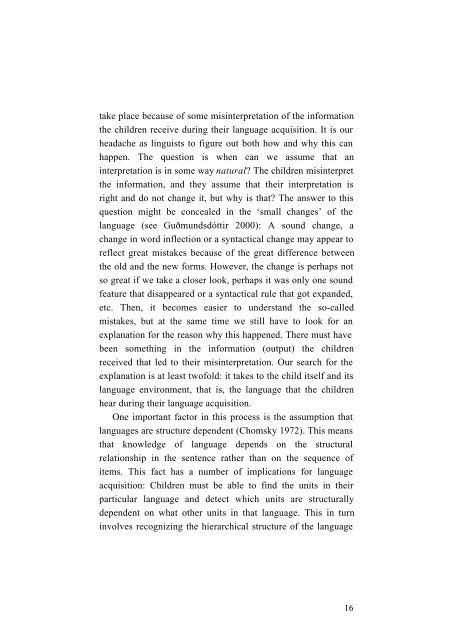Explaining language change: A three step process
Explaining language change: A three step process
Explaining language change: A three step process
You also want an ePaper? Increase the reach of your titles
YUMPU automatically turns print PDFs into web optimized ePapers that Google loves.
take place because of some misinterpretation of the information<br />
the children receive during their <strong>language</strong> acquisition. It is our<br />
headache as linguists to figure out both how and why this can<br />
happen. The question is when can we assume that an<br />
interpretation is in some way natural? The children misinterpret<br />
the information, and they assume that their interpretation is<br />
right and do not <strong>change</strong> it, but why is that? The answer to this<br />
question might be concealed in the ‘small <strong>change</strong>s’ of the<br />
<strong>language</strong> (see Guðmundsdóttir 2000): A sound <strong>change</strong>, a<br />
<strong>change</strong> in word inflection or a syntactical <strong>change</strong> may appear to<br />
reflect great mistakes because of the great difference between<br />
the old and the new forms. However, the <strong>change</strong> is perhaps not<br />
so great if we take a closer look, perhaps it was only one sound<br />
feature that disappeared or a syntactical rule that got expanded,<br />
etc. Then, it becomes easier to understand the so-called<br />
mistakes, but at the same time we still have to look for an<br />
explanation for the reason why this happened. There must have<br />
been something in the information (output) the children<br />
received that led to their misinterpretation. Our search for the<br />
explanation is at least twofold: it takes to the child itself and its<br />
<strong>language</strong> environment, that is, the <strong>language</strong> that the children<br />
hear during their <strong>language</strong> acquisition.<br />
One important factor in this <strong>process</strong> is the assumption that<br />
<strong>language</strong>s are structure dependent (Chomsky 1972). This means<br />
that knowledge of <strong>language</strong> depends on the structural<br />
relationship in the sentence rather than on the sequence of<br />
items. This fact has a number of implications for <strong>language</strong><br />
acquisition: Children must be able to find the units in their<br />
particular <strong>language</strong> and detect which units are structurally<br />
dependent on what other units in that <strong>language</strong>. This in turn<br />
involves recognizing the hierarchical structure of the <strong>language</strong><br />
16

















